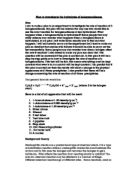The aim of this experiment is to show how the rate of reaction of the halogenoalkanes changes in respect to the C-X bond, where the C is the carbon and the X is the halogen (C?Cl, C?Br, C?I).
Halogenoalkanes (also known as haloalkanes or alkyl halides) are compounds containing a halogen atom (fluorine, chlorine, bromine or iodine) joined to one or more carbon atoms in a chain. These are used in society as anaesthetics, plastics, solvents and as intermediates in reactions. The focus of these compounds is the carbon?halogen bond and all the nucleophilic substitution reactions of the halogenoalkanes involve breaking this bond.
One of the main ways that halogenoalkanes react is by nucleophilic substitution. We can write a general equation for nucleophilic substitution using :N¯ to represent any negatively charged nucleophile:
Their reactions are characterised by nucleophilic substitution of the halogen atom, owing to polarity of the carbon?halogen bond (C???X?-) in which the electron-deficient carbon (C??? is susceptible to attack by an electron-rich species, namely a nucleophile which can result in the displacement of the halide: X- (aq) ion. The nucleophile attaches itself to the C???atom while the halogen leaves as a halide ion (leaving group), taking the electrons of the C?X bond with it. The rate of substitution depends on the halogen due to the strength of the C?X bond.
Halogenoalkanes (also known as haloalkanes or alkyl halides) are compounds containing a halogen atom (fluorine, chlorine, bromine or iodine) joined to one or more carbon atoms in a chain. These are used in society as anaesthetics, plastics, solvents and as intermediates in reactions. The focus of these compounds is the carbon?halogen bond and all the nucleophilic substitution reactions of the halogenoalkanes involve breaking this bond.
One of the main ways that halogenoalkanes react is by nucleophilic substitution. We can write a general equation for nucleophilic substitution using :N¯ to represent any negatively charged nucleophile:
Their reactions are characterised by nucleophilic substitution of the halogen atom, owing to polarity of the carbon?halogen bond (C???X?-) in which the electron-deficient carbon (C??? is susceptible to attack by an electron-rich species, namely a nucleophile which can result in the displacement of the halide: X- (aq) ion. The nucleophile attaches itself to the C???atom while the halogen leaves as a halide ion (leaving group), taking the electrons of the C?X bond with it. The rate of substitution depends on the halogen due to the strength of the C?X bond.







